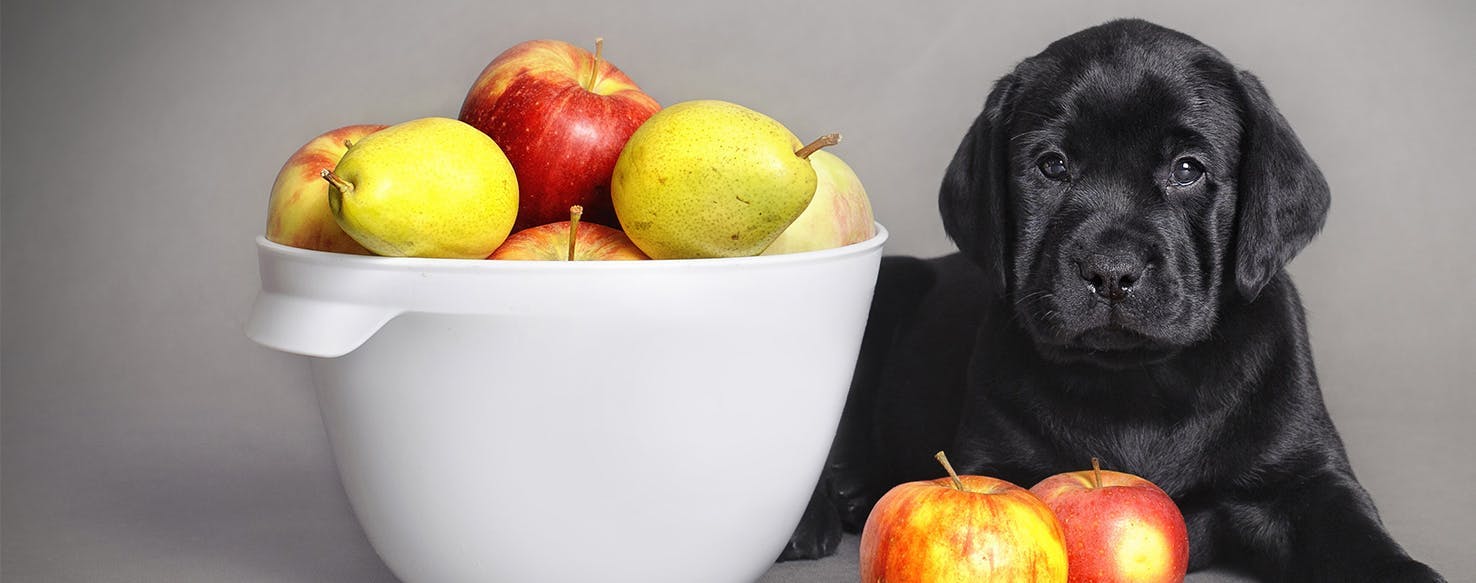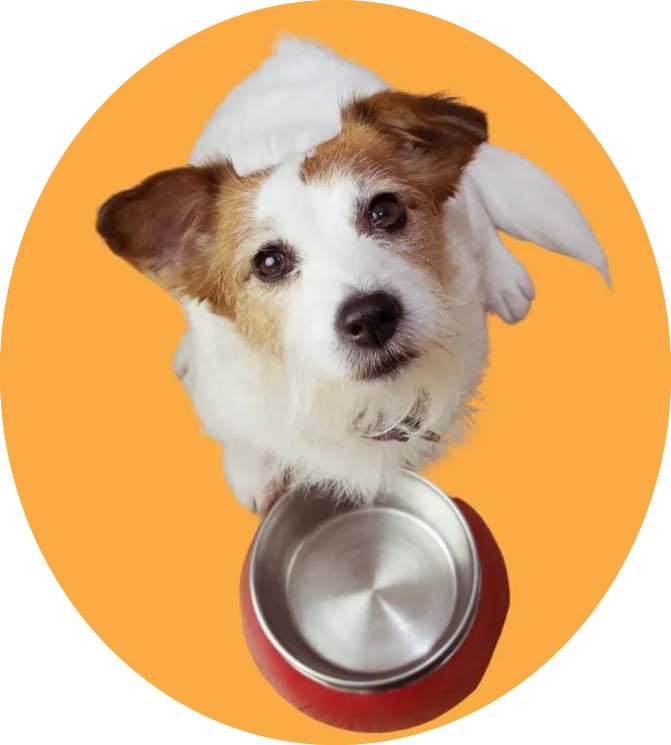
By Wag! Staff
Published: 10/02/2023, edited: 06/14/2024
More articles by Wag! Staff
Save on pet insurance for your pet
You don't have to choose between your pet and your wallet when it comes to expensive vet visits. Prepare ahead of time for unexpected vet bills by finding the pawfect pet insurance.
- Apples: Apples contain vitamin A and C, calcium, phosphorus as well as antioxidants. They’re low-calorie but high in fiber, which helps to manage their weight. Plus, they help to prevent the build-up of plaque and freshen your pup’s breath.
- Bananas: Some benefits of bananas are vitamins B6 and C, biotin, magnesium, fiber as well as potassium, all of which are good for your dog’s digestion and heart.
- Blueberries: These juicy berries contain vitamins C and K, fiber, phytochemicals, minerals and antioxidants as well as being a low-calorie snack. They contribute to healthy digestion, help preserve brain health, prevent cell damage, plus they fight both cancer and heart disease.
- Cantaloupe: Fiber, vitamins A, C, B6 and potassium are all found in this fruit. It’s a low-calorie snack that is mostly formed of water — which helps with hydration. Antioxidants prevent cancers and disease while slowing down the aging process. It also helps with digestion.
- Cranberries: Anti-inflammatory and anti-microbial properties in cranberries prevent harmful bacteria such as E.coli from growing. They help to keep your pup’s teeth white, breath fresh, and even prevent gum disease. They can also prevent UTIs.
- Kiwis: Vitamins A, C, E and K as well as potassium, calcium, beta carotene and lutein are all in this delicious fruit. A key benefit is that they help to support eye health.
- Mango: The fiber found in mangoes helps to improve digestion while it also contains antioxidants and minerals including A, B6, C and E.
- Oranges: This citrus fruit benefits from vitamins A and C, fiber, carotene, potassium and magnesium. It supports bone growth, vision and the digestive system.
- Peaches: Vitamins A, C and E, fiber, potassium, and magnesium are all in this juicy fruit.
- Pears: This fruit is low-calorie. It helps to aid digestion thanks to the fiber and has nutrients such as potassium and vitamin C.
- Pineapple: Vitamins and minerals including magnesium, potassium, iron and vitamin C are all found in pineapples.
- Raspberries: These berries are high in fiber, antioxidants and vitamin C while being low in both sugar and calories.
- Strawberries: High in folic acid, magnesium and potassium, strawberries support your dog’s immune system due to the vitamin c and antioxidants. The polyphenols are anti-inflammatory and can fight cancer and disease. They also help to keep teeth white and their breath fresh.
- Watermelon: Vitamin A, B6 and C help with their vision, bone growth and cognitive function as well as boosting immunity. It also contains fiber, potassium and lycopene — an antioxidant that reduces the risk of cancer. It’s low calorie and is more than 90% water, perfect for hydration.
- Broccoli: This superfood is a source of protein and fiber. It has calcium, iron and folic acid as well as vitamins A, C, E and K. This reduces the risk of cancer and helps their heart health.
- Brussels sprouts: Another superfood for your dog? Yes please! With brussels sprouts, chronic disease and cancer have a higher chance of being prevented due to the potassium and folate alongside vitamins A, B1 and B6.
- Carrots: If your puppy is teething, carrots are ideal pain relief. For adults, it also improves their dental health by removing bacteria. They contain both soluble and insoluble fiber. The latter removes toxins from the intestinal tract and stimulates movement here, as well as reducing cholesterol. Carrots also benefit from vitamins A and C, which prevent cells being damaged, improves vision and keeps their skin and coats healthy.
- Celery: Fat-free, low-calorie, with vitamins A, C and K plus potassium and folate, celery is great for teeth and gums as well as dog’s that need to lose a little weight.
- Cucumber: Fiber, potassium, magnesium and protein plus vitamins A, B1, B6, C and D are just a few of the benefits. Cucumber supports the immune system, is good for skin and coat, prevents bad breath as well as regulating blood pressure and blood sugar levels which helps dogs with diabetes. It’s also anti-inflammatory which is good for dogs with arthritis.
- Green beans: They offer protein while being low in fat. Magnesium, iron, potassium and vitamins are all in green beans. The antioxidants fight cancer while they also lower blood sugar levels, ideal for diabetic dogs.
- Peas: Vitamins A, C and K as well as minerals including iron and phosphorus are all in peas. They are high in fiber and protein and contain lutein. As well as being low-calorie they benefit skin, heart and eyes.
- Sweet potatoes: They are very high in fiber which can help their digestive system including with constipation. Full of vitamins, minerals and antioxidants, this delicious vegetable can fight against disease and cancer, support your furry friend’s vision and boost the immune system.
Some dogs, such as large breeds, require additional vitamins to aid in rapid bone growth, and many fruits and vegetables are an excellent way to meet these dietary requirements.
Antioxidants are also known for fighting against cancers and boosting your dog's immunity, so they are less likely to become ill. Adding fresh fruits and vegetables to your dog’s diet is an easy way to fight disease naturally.
Keeping your dog hydrated can also help prevent bladder stones from forming within your dog's bladder, kidney stones from forming within the kidneys, and blockages from occurring from the stones. Always offer your dog clean and fresh water, and supplement their diet with fruits and vegetables for their overall health.
Soluble fiber that comes from vegetables is digested later in your dog's system, helping to keep your dog regular and fight diseases in your dog's digestive system.
- Avocado: Technically your dog can eat avocado - but it’s best not to give them any. It contains a fungicidal toxin called Persin. It’s mostly in the pits, skin, leaves and bark but can also be found in the flesh in smaller amounts (higher if it’s not ripe.) While it’s more unlikely in dogs than other animals, there is a chance it can cause serious health issues.
- Cherries: Again, technically dogs can eat the flesh, but the leaves, pit and stem contain cyanide which is poisonous. So, it’s best to avoid entirely just to be on the safe side, especially as it would be easy for a dog to eat the whole cherry. The pit is also a choking hazard.
- Garlic: Heads up! This is very poisonous to dogs and can damage the red blood cells as well as causing stomach issues and respiratory problems. Powdered garlic is particularly dangerous for dogs.
- Grapes: Anything that contains grapes (including raisins) are very poisonous to dogs. It can cause severe kidney failure and can be fatal so they need to be seen by a vet immediately if they consume even one.
- Mushrooms: It’s wild mushrooms you need to be particularly aware of. They are very toxic for dogs. If they get hold of them, it can lead to kidney and liver failure, which could be fatal.
- Onions: Like garlic, this allium species is also toxic for pups and can damage red blood cells. This is particularly dangerous for Japanese breeds including Akitas and Shiba Inus.
- Tomatoes: Your dog can eat ripe tomatoes, but you must avoid unripe tomatoes as well as the stem and leaves which are toxic to your dog and can cause gastrointestinal upset.
- Offer a couple of pieces as a treat.
- Mash or cut it up into their food, either raw or cooked.
- Use it as a reward for training.
- Freeze for a refreshing treat on a hot day.
- Make it into a delicious smoothie.
- Search for a dog-friendly recipe and bake it into a treat.

